Effects of a Trench as a Moisture Harvesting Structure on the Biomass Production and Growth of Trees Planted to Restore Degraded Land, Southern Ethiopia
Abstract
1. Introduction
2. Materials and Methods
2.1. Description of the Project and Study Area
2.2. Data Collection
2.3. Data Analysis
3. Results
3.1. Growth of Trees
3.2. Biomass Production
4. Discussion
5. Conclusions
Author Contributions
Funding
Acknowledgments
Conflicts of Interest
References
- Zorn, M.; Komac, B. Land Degradation. In Encyclopedia of Natural Hazards; Bobrowsky, P.T., Ed.; Encyclopedia of Earth Sciences Series; Springer: Dordrecht, The Netherlands, 2013. [Google Scholar] [CrossRef]
- Johnson, D.L.; Lewis, L.A. Land Degradation Creation and Destruction, 2nd ed.; Rowman and Littlefield Publishers INC.: Lanham, MD, USA, 2007; p. 307. [Google Scholar]
- Acharya, A.K.; Kafle, N. Land degradation issues in Nepal and its management through agroforestry. J. Agric. Environ. 2009, 10, 115–123. [Google Scholar] [CrossRef]
- Yirdaw, E.; Tigabu, M.; Monge, A. Rehabilitation of degraded dryland ecosystems–review. Silva Fenn. 2017, 51, 1673. [Google Scholar] [CrossRef]
- Mueller, E.N.; Wainwright, J.; Parsons, A.J.; Turnbull, L. (Eds.) Patterns of Land Degradation in Drylands; Springer: London, UK, 2014; p. 383. [Google Scholar]
- Mebrat, W. Natural regeneration practice in degraded high lands of Ethiopia through area enclosure. Int. J. Environ. Prot. Policy 2015, 3, 120–123. [Google Scholar] [CrossRef]
- Bisaro, A.; Kirk, M.; Zdruli, P.; Zimmermann, W. Global drivers setting desertification research priorities: Insights from a stakeholder consultation forum. Land Degrad. Dev. 2014, 25, 5–16. [Google Scholar] [CrossRef]
- Hueso-González, P.; Martínez-Murillo, J.F.; Ruiz-Sinoga, J.D. The impact of organic amendments on forest soil properties under Mediterranean climatic conditions. Land Degrad. Dev. 2014, 25, 604–612. [Google Scholar] [CrossRef]
- Lieskovsky, J.; Kenderessy, P. Modelling the effect of vegetation cover and different tillage practices on soil erosion in vineyards: A case study in Vráble (Slovakia) using WATEM/SEDEM. Land Degrad. Dev. 2014, 25, 288–296. [Google Scholar] [CrossRef]
- Srinivasarao, C.; Venkateswarlu, B.; Lal, R.; Singh, A.K.; Kundu, S.; Vittal, K.P.R.; Patel, J.J.; Patel, M.M. Long-term manuring and fertilizer effects on depletion of soil organic carbon stocks under pearl millet-cluster bean-castor rotation in Western India. Land Degrad. Dev. 2014, 25, 173–183. [Google Scholar] [CrossRef]
- Hurni, H.; Solomon, A.; Amare, B.; Berhanu, D.; Ludi, E.; Portner, B.; Birru, Y.; Gete, Z. Land degradation and sustainable land management in the highlands of Ethiopia. In Global Change and Sustainable Development: A Synthesis of Regional Experiences from Research Partnerships; Hurni, H., Wiesmann, U., Eds.; Georaphica Bernensia: Bern, Switzerland, 2010; pp. 187–201. [Google Scholar]
- Johnson, D.L.; Ambrose, S.H.; Bassett, T.J.; Bowen, M.L.; Crummey, D.E.; Isaacson, J.S.; Johnson, D.N.; Lamb, P.; Saul, M.; Winter-Nelson, A.E. Meanings of environmental terms. J. Environ. Qual. 1997, 26, 581–589. [Google Scholar] [CrossRef]
- Gashaw, T.; Bantider, A.; Gebre-Silassie, H. Land degradation in Ethiopia: Causes, impacts and rehabilitation techniques. J. Environ. Earth Sci. 2014, 4, 98–104. [Google Scholar]
- Siyum, G.E.; Tassew, T.; Gidey, A. Effect of different moisture harvesting techniques on seedling survivals and growth of trees in degraded lands of Southern Tigray. Asian J. Res. Agric. For. 2019, 4, 1–10. [Google Scholar] [CrossRef]
- Coxhead, I.; Øygard, R. Land Degradation; Cambridge University Press: Cambridge, UK, 2007; pp. 146–161. [Google Scholar] [CrossRef]
- Gammoh, I.A. A mechanized system for establishment of forage shrubs in water harvesting micro-catchment structures. Int. J. Bot. 2011, 7, 145–153. [Google Scholar] [CrossRef]
- Li, W.Q.; Liu, X.-J.; Khan, M.A.; Gul, B. Relationship between soil characteristics and halophytic vegetation in coastal region of north China. Pak. J. Bot. 2008, 40, 1081–1090. [Google Scholar]
- Vohland, K.; Barry, B. A review of in situ rainwater harvesting (RWH) practices modifying landscape functions in African drylands. Agric. Ecosyst. Environ. 2009, 131, 119–127. [Google Scholar] [CrossRef]
- Jia, Y.; Li, F.M.; Wang, X.L.; Yang, S.M. Soil water and alfalfa yields as affected by alternating ridges and furrows in rainfall harvest in a semiarid environment. Field Crop Res. 2006, 97, 167–175. [Google Scholar] [CrossRef]
- Prinz, D. Water harvesting for afforestation in dry areas. In Proceedings of the 10th International Conference on Rainwater Catchment Systems, Mannheim, Germany, 10–14 September 2001; pp. 195–206. [Google Scholar]
- Derib, S.D.; Assefa, T.; Berhanu, B.; Zeleke, G. Impacts of micro-basin water harvesting structures in improving vegetative cover in degraded hill-slope areas of north-east Ethiopia. Rangel. J. 2009, 31, 259–265. [Google Scholar] [CrossRef]
- Yavitt, J.B.; Wright, S.J. Seedling growth responses to water and nutrient augmentation in the understorey of a lowland moist forest, Panama. J. Trop. Ecol. 2008, 24, 19–26. [Google Scholar] [CrossRef][Green Version]
- Singh, G. Enhancing growth and biomass production of plantation and associated vegetation through rainwater harvesting in degraded hills in southern Rajasthan, India. New For. 2012, 43, 349–364. [Google Scholar] [CrossRef]
- Ludwig, J.A.; Wilcox, B.P.; Breshears, D.D.; Tongway, D.J.; Imeson, A.C. Vegetation patches and run off erosion as interacting ecohydrological processes in semiarid landscapes. Ecology 2005, 86, 288–297. [Google Scholar] [CrossRef]
- Yang, X.-h.; Wang, K.-q.; Wang, B.-r.; Yu, C.-t. Afforestation using micro-catchment water harvesting system with microphytic crust treatment on semi-arid Loess Plateau: A preliminary result. J. For. Res. 2005, 16, 9–14. [Google Scholar] [CrossRef]
- Gupta, G.N. Rain water management for tree planting in Indian desert. J. Arid Environ. 1995, 31, 219–235. [Google Scholar] [CrossRef]
- Singh, G.; Khan, A.U.; Kumar, A.; Bala, N.; Tomar, U.K. Effects of rainwater harvesting and afforestation on soil properties and growth of Emblica officinalis while restoring degraded hills in western India. Afr. J. Environ. Sci. Technol. 2012, 6, 300–311. [Google Scholar] [CrossRef]
- Tiki, L.; Tadesse, M. Impacts of integrating different soil and water conservation measures into hillside area closure on woody species composition and structure in Hawassa Zuria district, Ethiopia. Wudpecker J. Agric. Res. 2015, 44, 40–49. [Google Scholar]
- Jonson, J.H.; Freudenberger, D. Restore and sequester: Estimating biomass in native Australian Woodland Ecosystems for their carbon-funded restoration. Aust. J. Bot. 2011, 59, 639–652. [Google Scholar] [CrossRef]
- Vidyasagaran, K.; Paramathma, M. Biomass prediction of Casuarina equisetifolia, forest plantations in the west coastal plains of Kerala, India. Indian J. Sci. Res. Technol. 2014, 2, 83–89. [Google Scholar]
- Mekonnen, Z. A holistic approach to the restoration of degraded natural resources: A review and synthesis. Res. J. Agric. Environ. Manag. 2013, 2, 58–68. [Google Scholar]
- Sumbali, S.; Koppad, A.G.; Gurav, M. Effect of soil moisture conservation structures and application of manures and fertilizers on growth of Acacia auriculiformis. Int. J. Environ. Sci. 2012, 1, 178–185. [Google Scholar]
- Panigrahi, B.; Panda, S.N.; Mal, B.C. Rainwater conservation and recycling by optimal size on-farm reservoir. Resour. Conserv. Recycl. 2007, 50, 459–474. [Google Scholar] [CrossRef]
- Manivannan, S.; Desai, A.R. Effect of in-situ moisture conservation practices on runoff, soil loss and initial growth of cashew (Anacardium occidentale). Indian J. Soil Conserv. 2007, 35, 147–150. [Google Scholar]
- Kumar, R.; Bhatnagar, P.R.; Kakade, V.; Dobhal, S. Tree plantation and soil water conservation enhances climate resilience and carbon sequestration of agro ecosystem in semi-arid degraded ravine lands. Agric. For. Meteorol. 2020, 282–283, 107857. [Google Scholar] [CrossRef]
- Shono, K.; Davies, S.T.; Chua, Y.K. Performance of 45 native tree species on degraded lands in Singapore. J. Trop. For. Sci. 2007, 19, 25–34. [Google Scholar]
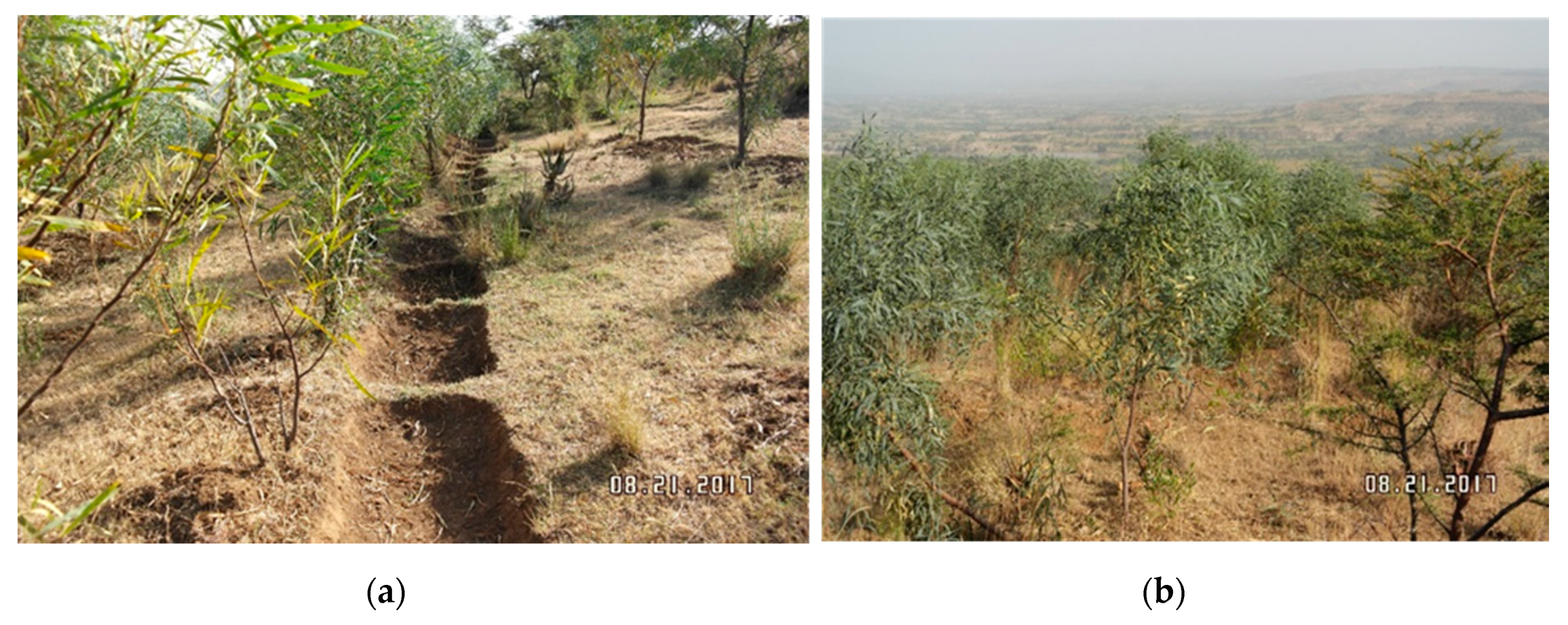
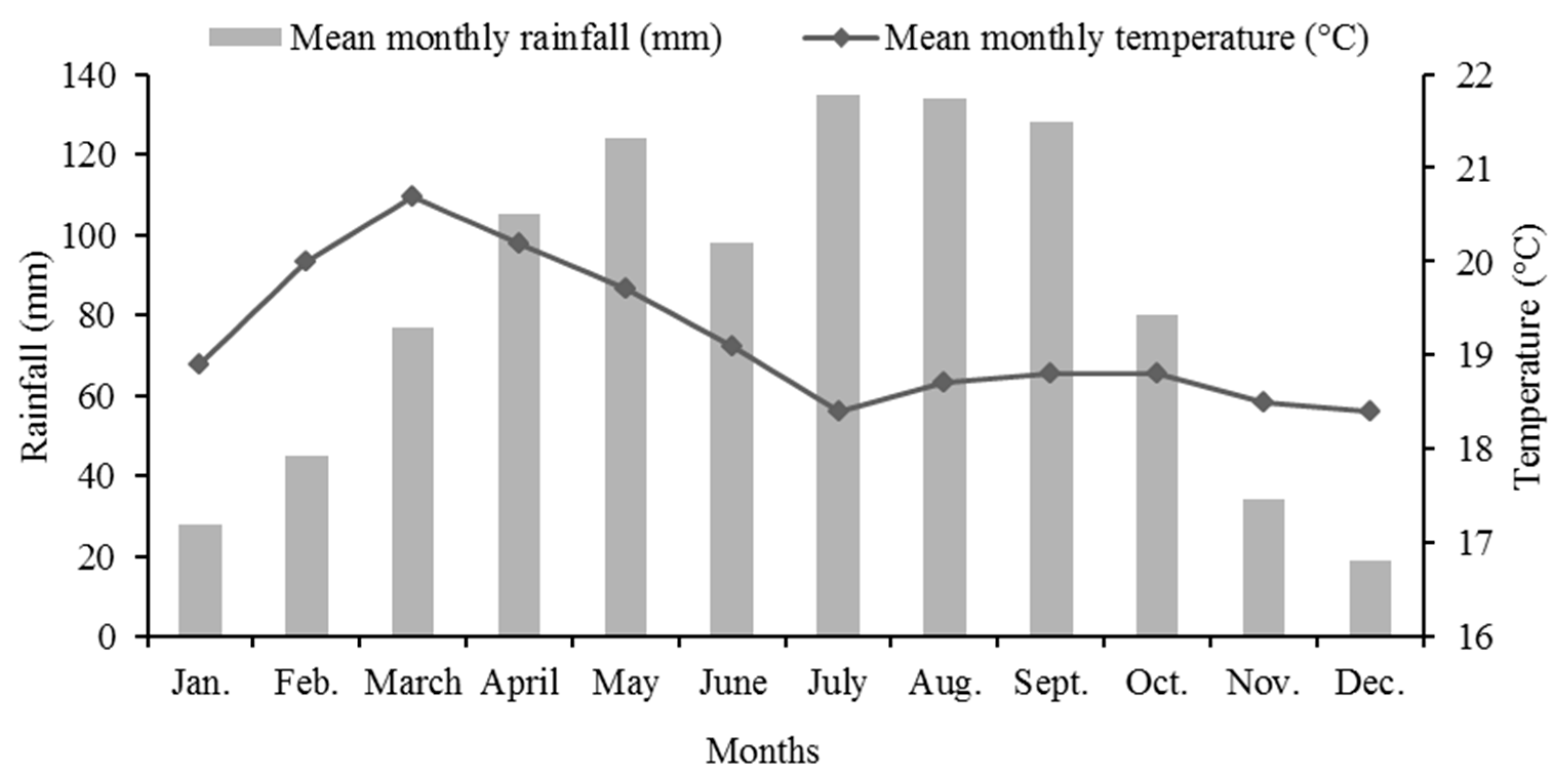
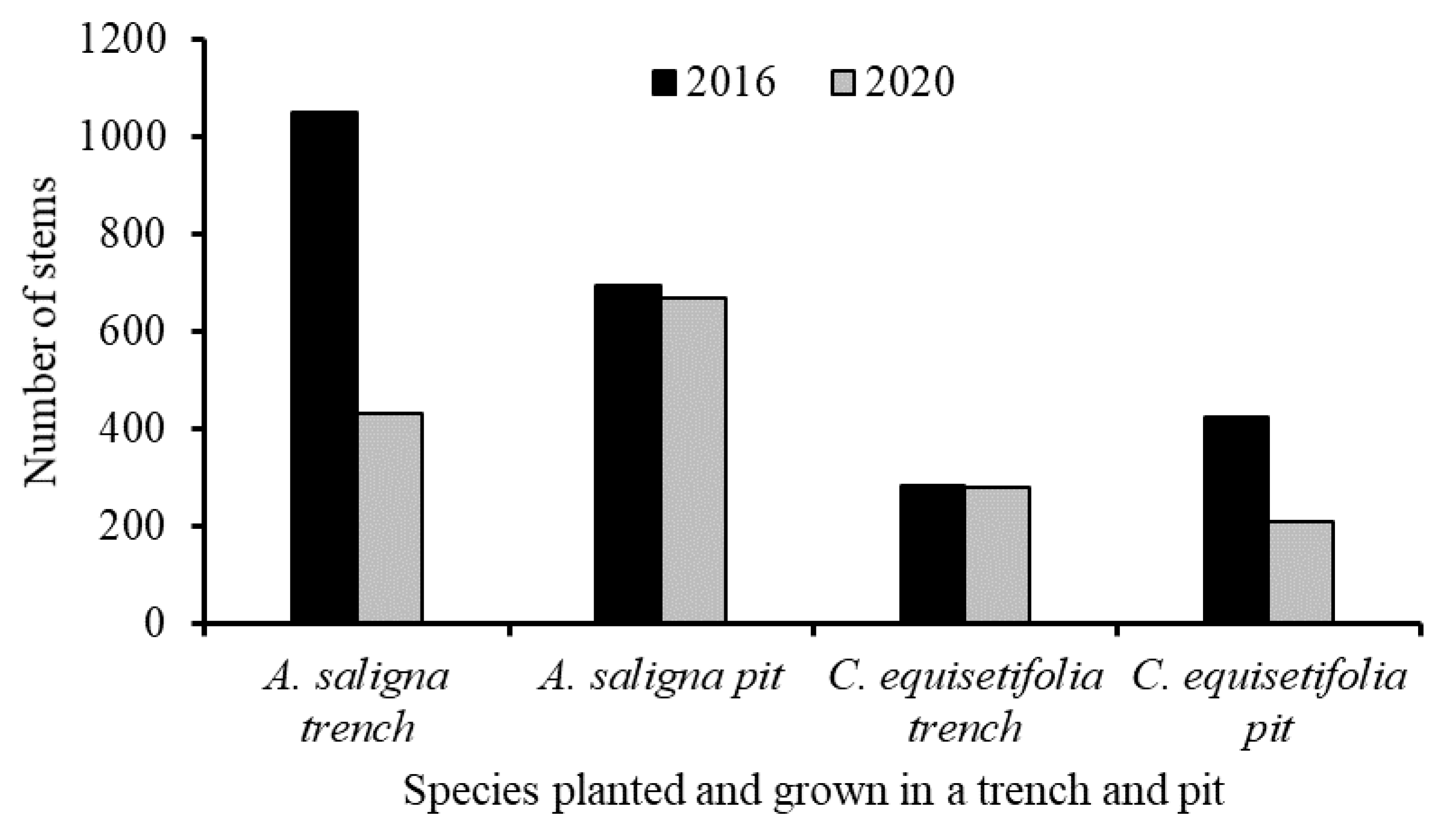
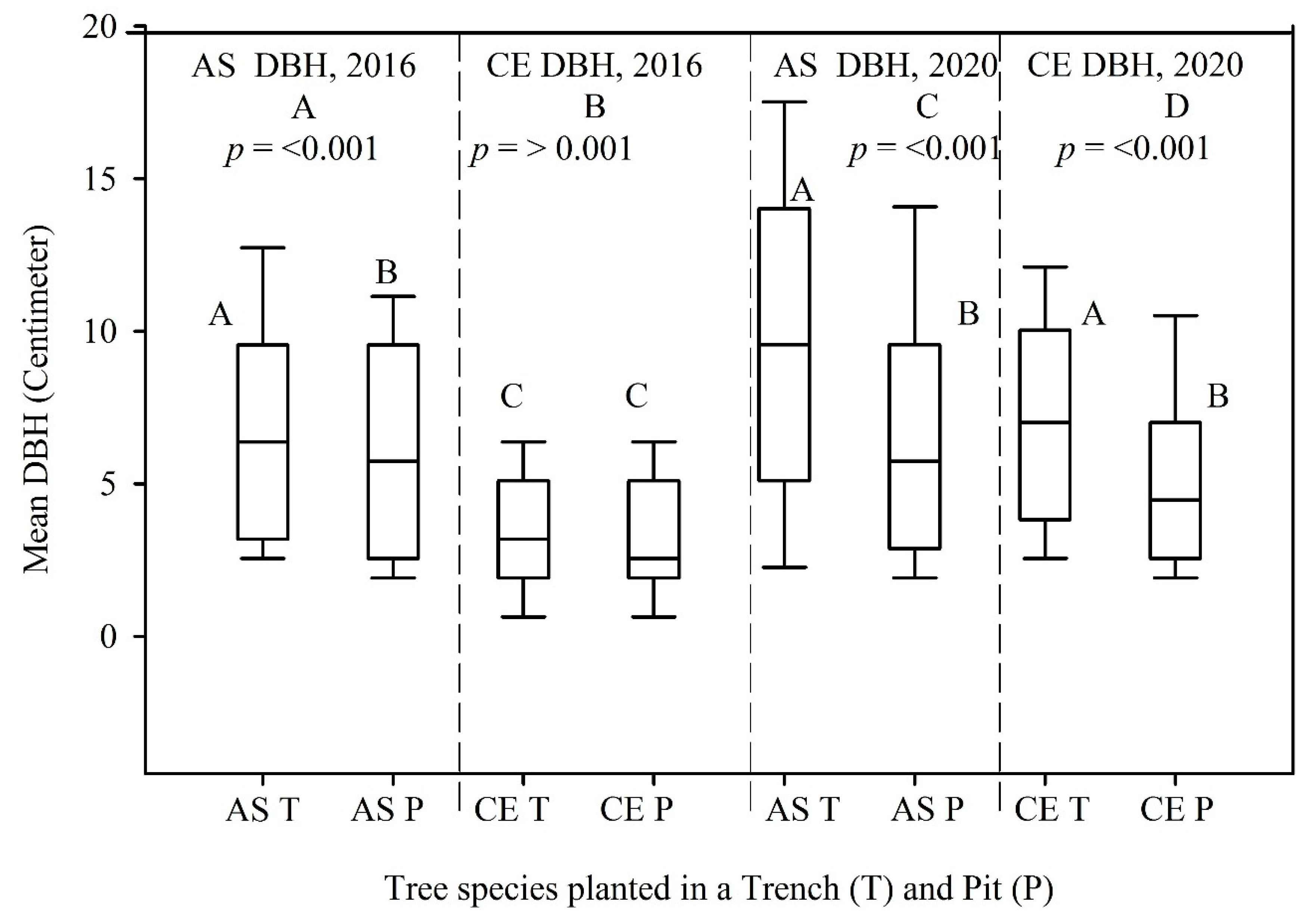
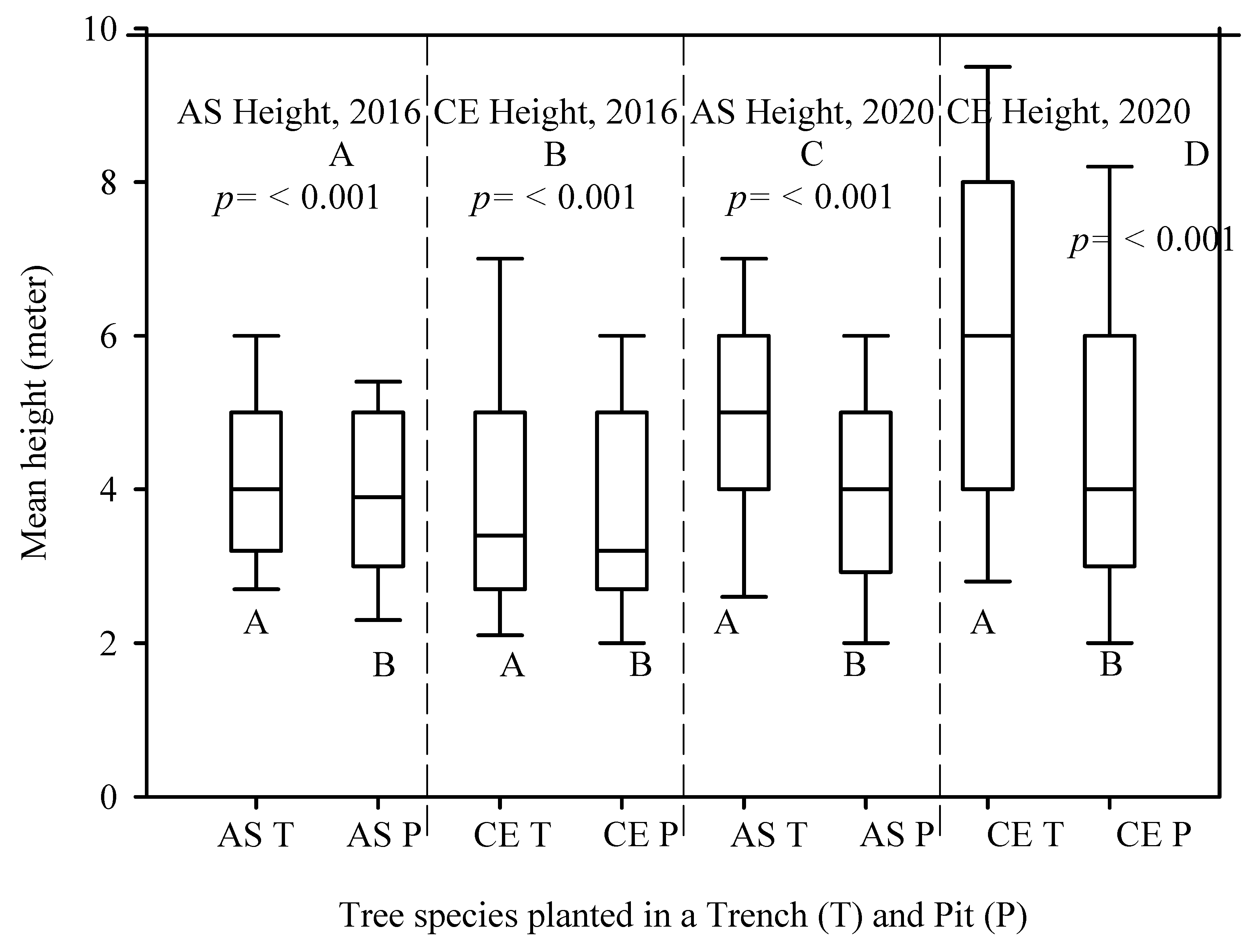


Publisher’s Note: MDPI stays neutral with regard to jurisdictional claims in published maps and institutional affiliations. |
© 2020 by the authors. Licensee MDPI, Basel, Switzerland. This article is an open access article distributed under the terms and conditions of the Creative Commons Attribution (CC BY) license (http://creativecommons.org/licenses/by/4.0/).
Share and Cite
Alem, S.; Němec, P.; Habrová, H. Effects of a Trench as a Moisture Harvesting Structure on the Biomass Production and Growth of Trees Planted to Restore Degraded Land, Southern Ethiopia. Appl. Sci. 2020, 10, 8560. https://doi.org/10.3390/app10238560
Alem S, Němec P, Habrová H. Effects of a Trench as a Moisture Harvesting Structure on the Biomass Production and Growth of Trees Planted to Restore Degraded Land, Southern Ethiopia. Applied Sciences. 2020; 10(23):8560. https://doi.org/10.3390/app10238560
Chicago/Turabian StyleAlem, Shiferaw, Petr Němec, and Hana Habrová. 2020. "Effects of a Trench as a Moisture Harvesting Structure on the Biomass Production and Growth of Trees Planted to Restore Degraded Land, Southern Ethiopia" Applied Sciences 10, no. 23: 8560. https://doi.org/10.3390/app10238560
APA StyleAlem, S., Němec, P., & Habrová, H. (2020). Effects of a Trench as a Moisture Harvesting Structure on the Biomass Production and Growth of Trees Planted to Restore Degraded Land, Southern Ethiopia. Applied Sciences, 10(23), 8560. https://doi.org/10.3390/app10238560




